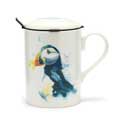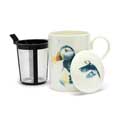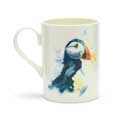Unhappy with your item? We offer no-quibble free returns
Sourced through ethical and sustainable accreditations
£3.95 standard UK shipping, or free shipping over £50
Every purchase you make supports wildlife



RSPB Life on the edge puffin tea infuser mug
Elegant puffin tea infuser made in the UK from bone china. Based on watercolour artwork by Devon-based artist Rachel Toll, this ceramic tea infuser captures the distinctive looks of the puffin.
Read full informationFREE UK delivery with orders over £50
Product description
Elegant puffin tea infuser made in the UK from bone china. Based on watercolour artwork by Devon-based artist Rachel Toll, this ceramic tea infuser captures the distinctive looks of the puffin.
Bone china tea infuser mug with a removable basket and lid included. The lid allows the full flavour of the tea to develop as it would in a teapot and helps keep the tea warm for longer.
- Suitable for use with tea leaves, tea bag, or ground coffee.
- Infuser basket is made from polypropylene. The filter is BPA free. The filter has been tested to the latest EU regulations in the Institute Fresenius/SGS in Germany, as well as conforming to UK and USA FDA standards.
- Dishwasher safe.
- Hand-washing is recommended for the infuser.
- Capacity is 325ml.
- Made in the UK.
- Matching oven glove, mug and tea towels also available.
Puffins are an unmistakable visitor to parts of our rockier coastline. They spend the winter out at sea, but come ashore in the spring and summer to breed and make nests in burrows in rocky cliffs. Their noisy colonies cling to the shoreline.
The RSPB has a number of reserves around the country where you might catch sight of puffins nesting in spring. RSPB Rathlin Island off the coast of Northern Ireland, Bempton Cliffs in Yorkshire, RSPB South Stack Cliffs on Anglesey or RSPB Fowlsheugh in Aberdeenshire are all excellent places to see this wonderful little bird.
It is estimated the British Isles provides a home to 10% of the world's puffin population. Their way of life is threatened by pollution and over-fishing of waters, as well as predators on land such as rats.
RSPB Life on the edge
Our new collection of homewares is inspired by coastal birds which spend life on both land and water. Beautifully illustrated by Rachel Toll, the puffins, gannets, dunlins, oystercatchers and avocets are some of our most precious species. They might migrate here or live offshore at different times of year, but they all call our shoreline home.
The RSPB is working together with other partners including National Trust, to improve the long term prospects for our coastal habitats. Click here to find out more about our LIFE on the edge project.
Rating Snapshot
Average Customer Reviews
Age: 55 - 64
10/Feb/2024
RSPB response
We are sorry that this product has not met with your satisfaction. Your comments have been passed on to the Product Development team and supplier for future developments.
- Free UK delivery for orders of £50 or more (or £3.95)*
- Please allow 3-5 working days for in stock items to be delivered
See our delivery and returns page for full details.


